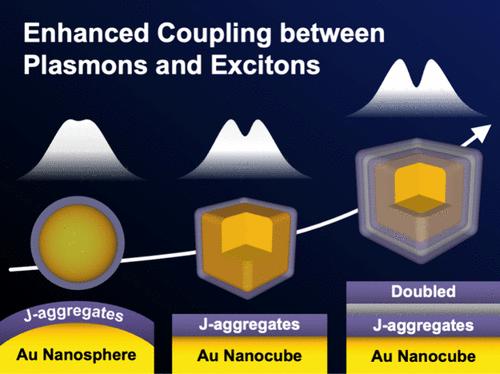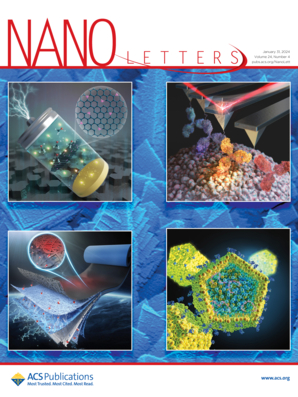Plasmon–Exciton Strong Coupling in Colloidal Au Nanocubes with Layered Molecular J-Aggregates
IF 9.6
1区 材料科学
Q1 CHEMISTRY, MULTIDISCIPLINARY
引用次数: 0
Abstract
Strong coupling between light and matter forms hybrid states, such as exciton–polaritons, which are crucial for advancements in quantum science and technology. Plasmonic metal nanoparticles, with their ultrasmall mode volumes, are effective for generating these states, but the coupling strength is often limited by surface saturation of excitonic materials. Additionally, cubic nanoparticles, which can generate strong local fields, have not been systematically explored. This study investigates strong coupling in Au nanocubes (AuNCs) coupled with J-aggregates, observing spectral splitting in both extinction and scattering spectra. Our findings suggest that smaller AuNCs, with higher-quality resonances and reduced mode volumes, achieve stronger coupling. Furthermore, a layer-by-layer (LBL) coating of J-aggregates on AuNCs results in a ∼21% increase in coupling strength. Simulations reveal the mechanism behind the enhanced coupling and confirm that the layering method effectively increases coupling, surpassing the limitations of the finite surface area of nanoparticles.

具有层状分子 J 聚合体的胶体金纳米立方体中的等离子体-放电子强耦合
光与物质之间的强耦合会形成混合态,如激子-极化子,这对量子科学和技术的进步至关重要。质子金属纳米粒子具有超小的模式体积,可有效产生这些状态,但其耦合强度往往受到激子材料表面饱和的限制。此外,立方纳米粒子可以产生很强的局部场,但尚未得到系统的研究。本研究调查了与 J-聚集体耦合的金纳米立方体(AuNCs)中的强耦合,观察了消光和散射光谱中的光谱分裂。我们的研究结果表明,较小的 AuNCs 具有更高质量的共振和更小的模式体积,可以实现更强的耦合。此外,在 AuNCs 上逐层 (LBL) 涂覆 J- 聚合体可使耦合强度提高 21%。模拟揭示了增强耦合背后的机制,并证实分层方法有效地增强了耦合,超越了纳米粒子有限表面积的限制。
本文章由计算机程序翻译,如有差异,请以英文原文为准。
求助全文
约1分钟内获得全文
求助全文
来源期刊

Nano Letters
工程技术-材料科学:综合
CiteScore
16.80
自引率
2.80%
发文量
1182
审稿时长
1.4 months
期刊介绍:
Nano Letters serves as a dynamic platform for promptly disseminating original results in fundamental, applied, and emerging research across all facets of nanoscience and nanotechnology. A pivotal criterion for inclusion within Nano Letters is the convergence of at least two different areas or disciplines, ensuring a rich interdisciplinary scope. The journal is dedicated to fostering exploration in diverse areas, including:
- Experimental and theoretical findings on physical, chemical, and biological phenomena at the nanoscale
- Synthesis, characterization, and processing of organic, inorganic, polymer, and hybrid nanomaterials through physical, chemical, and biological methodologies
- Modeling and simulation of synthetic, assembly, and interaction processes
- Realization of integrated nanostructures and nano-engineered devices exhibiting advanced performance
- Applications of nanoscale materials in living and environmental systems
Nano Letters is committed to advancing and showcasing groundbreaking research that intersects various domains, fostering innovation and collaboration in the ever-evolving field of nanoscience and nanotechnology.
 求助内容:
求助内容: 应助结果提醒方式:
应助结果提醒方式:


